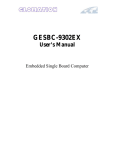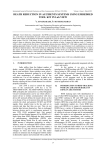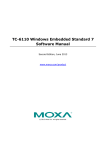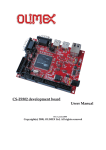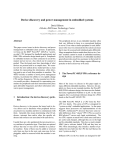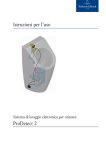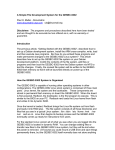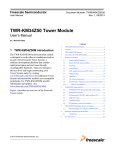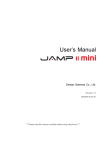Download GESBC-9302 User`s Manual
Transcript
GESBC-9302 User’s Manual Embedded Single Board Computer GESBC-9302 User’s Manual Table of Contents Chapter 1 – Introducing the GESBC-9302 Single Board Computer .................................4 GESBC-9302 Overview ..............................................................................................4 Advanced Features ......................................................................................................4 EP9302........................................................................................................................5 SDRAM ......................................................................................................................5 FLASH........................................................................................................................5 USB ............................................................................................................................5 UART 1 ......................................................................................................................5 UART 2 ......................................................................................................................5 Ethernet .......................................................................................................................6 Chapter 2 – Getting Started .............................................................................................6 Assembly and Connections..........................................................................................6 Operation ....................................................................................................................7 Configurations.............................................................................................................9 Chapter 3 – GESBC-9302 Function Blocks ...................................................................10 EP9302......................................................................................................................10 SDRAM ....................................................................................................................11 FLASH......................................................................................................................12 USB ..........................................................................................................................12 UART 1 and 2 ...........................................................................................................12 Ethernet .....................................................................................................................13 SPI bus ......................................................................................................................13 On-chip A/D..............................................................................................................14 GPIO.........................................................................................................................14 JTAG ........................................................................................................................15 Optional A/D and D/A...............................................................................................15 Power Requirement ...................................................................................................16 Chapter 4 – Software Description ..................................................................................17 Overview...................................................................................................................17 GESBC-9302 Linux Code .........................................................................................17 Download Utility.......................................................................................................17 Redboot.....................................................................................................................18 Loading Linux Kernel and root File System...............................................................18 Chapter 5 – Development Tools ....................................................................................21 Overview...................................................................................................................21 Linux Development Tool Chain.................................................................................21 Native Application Development Over NFS ..............................................................23 Chapter 6 – Troubleshooting .........................................................................................25 Version 0.2 Page 2 of 25 21-Sep-06 GESBC-9302 User’s Manual List of Tables Table 1 System configuration ..........................................................................................9 Table 2 P1 UART1 connector........................................................................................12 Table 3 JP6 UART2 connector ......................................................................................13 Table 4 J11 SPI connector .............................................................................................13 Table 5 JP3 On-chip A/D converter...............................................................................14 Table 6 J1 GPIO 1 connector.........................................................................................14 Table 7 J2 GPIO 2 connector.........................................................................................14 Table 8 JP5 JTAG connector .........................................................................................15 Table 9 J30 Optional A/D and D/A connector...............................................................15 Table 10 J7 Power supply connector..............................................................................16 Version 0.2 Page 3 of 25 21-Sep-06 GESBC-9302 User’s Manual Chapter 1 – Introducing the GESBC-9302 Single Board Computer GESBC-9302 Overview The GESBC-9302 a low cost compact sized single board computer based on Cirrus Logic EP9302 processor. With a large peripheral set targeted to a variety of applications, the GESBC-9302 is well suited for industrial controls, digital media servers, audio jukeboxes, thin clients, set-top boxes, point-of-sale terminals, biometric security systems, and GPS devices will benefit from the EP9302's integrated architecture and advanced features. Advanced Features The heart of the GESBC-9302 is the EP9302 which is the one in a series of ARM920Tbased processors. The ARM920T microprocessor core with separate 16 Kbyte 64-way set-associative instruction and data caches is augmented by the MaverickCrunch™ coprocessor. This enables faster than real-time compression of audio CDs. The proprietary MaverickKey™ unique hardware programmed IDs provide an excellent solution to the growing concern over secure Web content and commerce. MaverickKey IDs can also be used by OEMs and design houses to protect against design piracy by presetting ranges for unique IDs. The EP9302 is a high-performance, low-power RISC-based device built around a single ARM920T microprocessor core. The ARM920T on the EP9302 functions with a maximum operating clock rate of 200MHz and a power usage between 100mW and 750mW (dependent upon clock speed). The ARM core operates from a 1.8V supply while the I/O operates at 3.3V. The low power consumption makes it an idea platform for battery operated applications. A high performance 1/10/100 Mbps Ethernet Media Access Controller (EMAC) is included along with external interfaces to SPI and I2S Audio. A two-port USB host and two UARTs are included as well. The list below summarizes the features of the GESBC9302. • • • • • • • • • • 200MHz Processor Core – ARM920T with MMU MaverickCrunch™ Math Engine MaverickKey™ Security 32M SDRAM, 4~16M FLASH Ethernet Media Access Controller (EMAC) 5 channel 12-bit Analog-to-Digital Converter (ADC Universal Asynchronous Receiver / Transmitters (UARTs) with RS-485 Support 2 USB Host Port Real-Time Clock Hardware Debug Interface Version 0.2 Page 4 of 25 21-Sep-06 GESBC-9302 User’s Manual Figure 1 below show a picture of the GESBC-9302 Single Board Computer. Figure 1. GESBC-9302 Single Board Computer EP9302 The GESBC-9302 is shipped with the Cirrus Logic EP9302 processor. For more information regarding the EP9302 processor please see the EP9302 datasheet. SDRAM The GESBC-9302 is shipped with 32MBytes of SDRAM. FLASH The GESBC-9302 is shipped with 4MBytes of asynchronous Intel Strata-Flash. USB The GESBC-9302 is shipped with two USB host connections. UART 1 The GESBC-9302 is shipped with a 9-pin interface. UART 2 The GESBC-9302 is shipped with the 3 wire UART 2 interface. Version 0.2 Page 5 of 25 21-Sep-06 GESBC-9302 User’s Manual Ethernet The GESBC-9302 is shipped with a complete physical and MAC subsystem that is compliant with the ISO/TEC 802.3 topology for a single shared medium with several stations. The EP9302 supports 1/10/100 Mbps transfer rates and interfaces to industry standard physical layer devices such as the Cirrus Logic CS8952. Chapter 2 – Getting Started This chapter describes the GESBC-9302 working environment and familiarizes the user with its components and functionality. This chapter contains the following sections: • Assembly and Connections o Describes how to assemble and connect components to the GESBC-9302 Single Board Computer • Operation o Describes how to operate the GESBC-9302 Single Board Computer Assembly and Connections In order to use the GESBC-9302 the user must first assemble and connect the peripherals to the GESBC-9302, as described in the following procedure. 1. Place the GESBC-9302 on a static free surface. 2. Make sure all of the jumpers are in the factory default position. The unit is shipped in a factory default configuration. If the user is uncertain that the GESBC-9302 has the jumpers in the factory default configuration, please see the next section regarding board configuration. 3. Connect 5V regulated power supply to the board. 4. Connect null modem serial cable between GESBC-9302 UART 1 and PC/terminal serial port. 5. Launch a terminal emulator, such as HyperTerminal, or minicom, on the PC configured to connect to the serial port of the GESBC-9302. Configure the serial port with the following parameters: 57600 bits per second, 8 data bits, no parity, 1 stop bit, no flow control. 6. Connect the board to a local area network (optional) Version 0.2 Page 6 of 25 21-Sep-06 GESBC-9302 User’s Manual Operation The startup procedure for the GESBC-9302 is straightforward. First, the connection of the power harness is required. Second, the null modem serial interface cable must be connected to the UART1 connector. Third, connect the GESBC-9302 to a network that has Internet access. It is recommended that all other cables be tested to determine they are properly seated. A few seconds after applying power to the GESBC-9302, debug information will be displayed on the terminal program. The following figure shows what this should look like. Version 0.2 Page 7 of 25 21-Sep-06 GESBC-9302 User’s Manual Please see Chapter 4 – Software Description for more detail regarding the software functionality. Version 0.2 Page 8 of 25 21-Sep-06 GESBC-9302 User’s Manual Configurations Jumpers are used to configure the GESBC-9302 to operate in different mode. The following table lists all the settings for each jumper. Jumper 2 5 SW1 LED3 Version 0.2 Table 1 System configuration Description Boot mode: connect pin 1 and 2 - serial boot connect pin 2 and 3 - flash boot JATG open – reset signal disabled closed – reset signal enabled Reset switch header Power indicator LED header Page 9 of 25 21-Sep-06 GESBC-9302 User’s Manual Chapter 3 – GESBC-9302 Function Blocks EP9302 The GESBC-9302 Single Board Computer uses the Cirrus Logic EP9302 as the core processor on this development board. The top-level features of EP9302 processor are the following: • ARM920T RISC Core Processor • 200 MHz / 200 MIPS Performance • 16 Kbyte Instruction Cache • 16 Kbyte Data Cache • Linux and Windows CE enabled MMU o Note: Cirrus Logic to supply either a Linux port or a Windows CE port, including the respective board support package (BSP). • 100 MHz System Bus • MaverickCrunchTM Math Engine • MaverickKeyTM Security Features • 32 bit SDRAM Interface (Up To 4 Banks) • 32 / 16 bit SRAM / FLASH / ROM Interface • Serial EEPROM Interface • 10 / 100 Mbps Ethernet MAC • Two UARTs • Two-port USB Host • 5 channel 12 bit ADC • SPI Port • Serial Audio Interface • JTAG Interface More detailed information regarding the EP9302 processor can be found at www.cirrus.com and on the enclosed disk. Version 0.2 Page 10 of 25 21-Sep-06 GESBC-9302 User’s Manual SDRAM The EP9302 features a unified memory address model where all memory devices are accessed over a common address and data bus. The EP9302 can support a minimum of 1 to a maximum of 4 banks of 32-bit 66 or 100 MHz SDRAM. Additionally, the GESBC9302 supports 32 SDRAM density. The K4S56132 SDRAM manufactured by Samsung is a part that matches this requirement. The features of the Samsung SDRAM include the following: • JEDEC Standard 3.3V Power Supply • LVTTL Compatible with Multiplexed Address • 4 Bank Operation • MRS Cycle with Address Key Programs • CAS Latency of 2 Or 3 • Burst Length of 1, 2, 4, 8, and Full Page • Burst Type of Sequential and Interleave • All Inputs Are Sampled on Rising Edge of Clock • DQM for Masking • Auto and Self Refresh • 64ms Refresh Period Version 0.2 Page 11 of 25 21-Sep-06 GESBC-9302 User’s Manual FLASH As previously stated, the EP9302 features a unified memory address architecture. The EP9302 can support either NAND or NOR types of non-volatile flash memory for program code storage. The GESBC-9302 is shipped with 4 Mbytes of flash memory, which is provided by Intel E28F320J3A Strata FLASH memory device. The Intel Strata Flash memory device features include the following: • 150ns Initial Access Speed • 25 ns Asynchronous Page-Mode Reads • 32-Byte Write Buffer • Program and Erase Suspend Support • Flash Data Integrator, Common Flash Interface Compatible • 128-bit Protection Register • 64-Bit Unique Device Identifier • 64-Bit User Programmable OTP Cells • Absolute Protection with VPEN Tied to Ground • Individual Block Locking • High Density 32 Kbyte Blocks USB The GESBC-9302 Single Board Computer provides two USB host connections. The EP9302 USB host controller is configured for two root hub ports and features an integrated transceiver for each port. The EP9302 integrates two USB 2.0 Full Speed host ports. These ports are fully compliant to the OHCI USB 2.0 Full Speed specification (12 Mbps). The controller complies with the OHCI specification for USB Revision 1.1. The USB ports are brought out by a standard double deck USB type A connector. UART 1 and 2 The GESBC-9302 Single Board Computer is shipped with 2 3-wire UART interface. The UART 1 interface is provided via a standard DB-9 connector. The signal designation is listed in the following tables. Pin Number 1 3 5 Version 0.2 Table 2 P1 UART1 connector Signal Name Pin Number DC 2 TX 4 GND 6 Page 12 of 25 Signal Name RX DTR DSR 21-Sep-06 GESBC-9302 User’s Manual 7 9 RTS RI 8 10 CTS N/A Table 3 JP6 UART2 connector Pin Number Signal Name 1 RX 2 TX 3 GND Ethernet The GESBC-9302 Single Board Computer is shipped with support for a complete Ethernet interface. The EP9302 contains a MAC subsystem that is compliant with the ISO/TEC 802.3 topology for a single shared medium with several stations. The Media Access Controller (MAC) within the EP9302 supports 1/10/100 Mbps transfer rates and interfaces to industry standard physical layer devices. The GESBC-9302 is shipped with the Cirrus Logic CS8952 CrystalLan 100Base-X / 10Base-T Transceiver device which, along with a RJ45 connector, provides the physical layer interface. The CS8952 features include the following: • • • • • Single Chip 802.3 Physical Interface IC Adaptive Equalizer Provides Extended Length Operation Extremely Low Transmit Jitter (<400ps) Low Common Mode Noise Six LED Drivers for Status Information SPI bus The GESBC-9302 Single Board Computer is shipped with a SPI expansion bus header for peripheral expansion. The signal designation is listed in the following table. Table 4 J11 SPI connector Pin Number Signal Name 1 SFRM 2 SSPRX 3 GND 4 SCLK 5 GND 6 SSPTX Version 0.2 Page 13 of 25 21-Sep-06 GESBC-9302 User’s Manual On-chip A/D The GESBC-9302 Single Board Computer is shipped with a 5 channel 12 bit on-chip A/D converter. The signal designation is listed in the following table. Table 5 JP3 On-chip A/D converter Pin Number Signal Name 1 GND 2 Channel 1 3 Channel 2 4 GND 5 GND 6 Channel 3 7 Channel 4 8 GND 9 GND 10 Channel 5 GPIO The GESBC-9302 Single Board Computer provides 20 general purpose I/O signals for external use. The signal designation is listed in the following tables. Pin Number 1 3 5 7 9 11 13 15 17 19 Table 6 J1 GPIO 1 connector Signal Name Pin Number EGPIO8 2 EGPIO10 4 EGPIO12 6 EGPIO14 8 GPIO0 (CGPIO[0]) 10 GPIO2 (HGPIO[4]) 12 GPIO4 (HGPIO[2]) 14 GPIO6 (FGPIO[2]) 16 GND 18 VDD3.3 20 Signal Name EGPIO9 EGPIO11 EGPIO13 EGPIO15 GPIO1 (HGPIO[5]) GPIO3 (HGPIO[3]) GPIO5 (FGPIO[1]) GPIO7 (FGPIO[3]) GND VDD3.3 The GPIO3 and GPIO4 are used for optional A/D and D/A chip select when they are installed. Pin Number 1 3 5 Version 0.2 Table 7 J2 GPIO 2 connector Signal Name Pin Number EGPIO2 2 EGPIO4 4 GND 6 Page 14 of 25 Signal Name EGPIO3 EGPIO5 VDD3.3 21-Sep-06 GESBC-9302 User’s Manual EGPIO 8 – 15 are connected directly to Port B of EP9302 CPU, EGPIO 2 – 5 are connected directly to Port A of EP9302 CPU. The GPIO 0 is mapped to Port C of EP9302 CPU. The GPIO 1 – 4 are mapped to Port H of EP9302 CPU which must be enabled in the DeviceCFG register at address 0x8093_0080 1 . The GPIO 5 -7 are mapped to EP9302 port F. JTAG The GESBC-9302 Single Board Computer is shipped with a 20 pin JTAG connector. The JTAG provides the user with the ability to debug system level programs. The signal designation is listed in the following table. Pin Number 1 3 5 7 9 11 13 15 17 19 Table 8 JP5 JTAG connector Signal Name Pin Number VDD3.3 2 TRST 4 TDI 6 TMS 8 TCK 10 TCK 12 TDO 14 RESET 16 NC 18 NC 20 Signal Name VDD3.3 GND GND GND GND GND GND GND GND GND Optional A/D and D/A The GESBC-9302 Single Board Computer provides support for optional 12 bit 8 channel A/D and 4 channel 12 bit D/A. The A/D is provided by TI ADS7870 which is a 12 bit 8 channel analog to digital converter with programmable gain amplifier. It also provides 4 programmable digital I/O. The maximum sampling rate of ADS7870 is 100 ksps. The 8 single ended analog inputs can be also configured as 4 pairs of differential input channels. The optional D/A is provided via TI DAC7554 which is a voltage output 12 bit 4 channel digital to analog converter. The A/D and D/A interface is provided via a 2x10 2.54mm header. The signal designation is listed in the following table. Pin Number 1 Table 9 J30 Optional A/D and D/A connector Signal Name Pin Number Signal Name DIO0 2 DIO1 1 The EP9301/02 user guide does not provide clear documentation on the bit for port H. Please refer to page 145 of EP9315 user guide for Port H configuration bit. Version 0.2 Page 15 of 25 21-Sep-06 GESBC-9302 User’s Manual 3 5 7 9 11 13 15 17 19 DIO2 VDD5 AIN0 AIN2 AIN4 AIN6 AGND AOUT0 AOUT2 4 6 8 10 12 14 16 18 20 DIO3 DGND AIN1 AIN3 AIN5 AIN7 AGND AOUT1 AOUT3 Power Requirement The GESBC-9302 Single Board Computer requires regulated 5v DC. Table 10 J7 Power supply connector Pin Number Signal Name 1 5V DC 2 GND Version 0.2 Page 16 of 25 21-Sep-06 GESBC-9302 User’s Manual Chapter 4 – Software Description Overview This chapter provides information regarding the software that is shipped with the GESBC-9302 Board. The software included with the board is Linux with a few test applications and network utilities. The Linux software provides the user with the ability to test some of the subsystems on the GESBC-9302 board. The download utility provides a means to program a binary image into the flash memory on the GESBC-9302. GESBC-9302 Linux Code The pre-programmed software provides the user with the opportunity to test some of the subsystems on the GESBC-9302 via Linux. This software is programmed into the system FLASH located on the board prior to shipment. The binary image of the shipped code is included on the CD that ships with the board. Serial Port Interface The functionality of the serial interface can be demonstrated by looking at the debug messages while the system boot-ups and operates. The setting for the serial interface is described in chapter 2. USB Interface The functionality of the USB interface can be shown by hooking up a user supplied USB device. Ethernet Interface Ethernet is automatically detected by the Linux kernel and a DHCP client will try to lease network address from connected DHCP server. Download Utility The download utility provides the user with a tool for programming the flash memory on the GESBC-9302 with a binary image. The following procedure will allow in-circuit programming of the flash memory via the EP9302 processor: 1) 2) 3) 4) 5) Power the board off. Connect null-modem serial cable to UART1. Set jumper 2 to connect pin 1 and 2 (JP2 factory default is pin 2 and 3). Stop any program that might use the serial port that is connected to GESBC-9302. Run download utility (assuming download_win.exe located in same directory as binary image) download_win binary_image_filename.bin 6) “Waiting for board to wake up…” message is displayed. 7) Power the board on. Version 0.2 Page 17 of 25 21-Sep-06 GESBC-9302 User’s Manual 8) Messages displayed regarding erasing, then programming the flash. 9) “Successfully programmed binary_image_filename.bin” message displayed upon programming completion. 10) Power the board off. 11) Install jumper on pin 2 and 3 of JP2. 12) Power the board on. Redboot RedBoot provides a simple interface for loading operating systems and applications onto the GESBC-9302 board. It can also serve as a debug platform for standalone programs using the GDB stub that is built into RedBoot. RedBoot uses a serial console for its input and output. The default serial port setting is 57600,8,N,1. It also supports the built-in Ethernet port and a flash file system and general flash programming. The board is shipped with Redboot pre-installed. Please refer to Download Utility section for instructions to reload Redboot. Please refer to documents at ECOS website http://ecos.sourceware.org regarding how to rebuild Redboot. Loading Linux Kernel and root File System The Redboot boot-loader provides two ways to load Linux kernel and file system into FLASH memory, by Ethernet network and TFTP server or serial connection. The network connection method provides fast loading but if not available, serial port connection method can be used. After power on the GESBC-9302 board, the following message should be shown on the terminal console on the host PC connected to the GESBC-9302 board2. +FLASH configuration checksum error or invalid key EP93xx - no EEPROM, static ESA, or RedBoot config option. No network interfaces found RedBoot(tm) bootstrap and debug environment [ROMRAM] Non-certified release, version v2_0 - built 07:39:29, Dec 18 2004 Platform: Cirrus Logic EDB9301 Board (ARM920T) Rev A Copyright (C) 2000, 2001, 2002, Red Hat, Inc. RAM: 0x00000000-0x04000000 available 2 A slightly different message will be displayed if the FLASH memory has been initialized and programmed before. Version 0.2 Page 18 of 25 21-Sep-06 GESBC-9302 User’s Manual FLASH: 0x60000000 - 0x60400000, 16 blocks of 0x00040000 bytes each. RedBoot> It’s possible to use bootp of Redboot to acquire network address automatically. For situation it is not available, the following procedure can be used to configure a static IP address for the SBC. RedBoot> fconfig Run script at boot: true Boot script: Enter script, terminate with empty line >> fis load ramdisk >> fis load zImage >> exec -r 0x800000 -s 0x300000 >> Boot script timeout (1000ms resolution): 1 Use BOOTP for network configuration: false Gateway IP address: Local IP address: 192.168.0.112 Local IP address mask: Default server IP address: DNS server IP address: Set eth0 network hardware address [MAC]: true eth0 network hardware address [MAC]: 0x00:0x00:0x00:0x00:0x80:0x21 GDB connection port: 9000 Force console for special debug messages: false Network debug at boot time: false Update RedBoot non-volatile configuration - continue (y/n)? y ... Erase from 0x60780000-0x60781000: . ... Program from 0x03fbe000-0x03fbf000 at 0x60780000: . RedBoot> The Redboot FLASH file system must be initialized in order to store data in the FLASH file system. The following procedure is used to initialize the Redboot FIS. RedBoot> fis init About to initialize [format] FLASH image system - continue (y/n)? y *** Initialize FLASH Image System Warning: device contents not erased, some blocks may not be usable ... Erase from 0x607c0000-0x60800000: . ... Program from 0x03fbf000-0x03fff000 at 0x607c0000: . RedBoot> Version 0.2 Page 19 of 25 21-Sep-06 GESBC-9302 User’s Manual Load Root File System3 The default configuration of GESBC-9302 is using part of SDRAM as RAM disk for Linux root file system. The ramdisk image must be stored in the on-board FLASH memory and loaded by Redboot for the Linux kernel. The image must be loaded into dynamic memory before it can be stored in the on board FLASH memory. To load the ramdisk file to SDRAM, enter the following commands at the terminal console, load –v –r –b 0x800000 –h tftp_host_ip ramdisk_file_name where -v : verbose -r : binary format -b : base address in memory for serial port download, the command is, load –v –r –b 0x800000 –m ymodem Immediately after entered the above serial download command, start Y-Modem transfer on the terminal program, the download process should start. The above commands will load ramdisk file into on board SDRAM. To store the image into non-volatile FLASH memory, use the following command, fis create –b 0x800000 –l <ramdisk_file_length> ramdisk_file_name where -b : is the memory base address -l : is the ramdisk size. It can be calculated by subtracting the end address from the base address from the Redboot response when loading the ramdisk file. The ramdisk_file_name can be any arbitrary name. To verify the image has been stored correctly in the FLASH memory, use the following command, fis list Load Linux Kernel The kernel image must be loaded into dynamic memory before it can be stored in the onboard FLASH memory. To load Linux kernel, issue the following command at the terminal console connected to the GESBC-9302 board, The host computer should have tfpt server running and Linux kernel and file system file stored in the tftp root directory. 3 Version 0.2 Page 20 of 25 21-Sep-06 GESBC-9302 User’s Manual load –v –r –b 0x80000 –h host_ip_address kernel_image_name where -v : verbose -r : binary format -b : base address in memory The above command will load Linux kernel image file into on board SDRAM. To store the image into non-volatile FLASH memory, use the following command, fis create –b 0x80000 –l <kernel_image_length> kernel_image_name where -b : is the memory base address -l : is the kernel image size. It can be calculated by subtracting the end address from the base address from the Redboot response when loading the kernel image file. The kernel_image_name can be any arbitrary name. To verify the image has been stored correctly in the FLASH memory, use the following command, fis list Multiple kernel images or root file systems can be stored in the on-board FLASH memory when memory space permits. Chapter 5 – Development Tools Overview This chapter provides a brief introduction to development tools that are available for the EP9302 System-on-a-Chip processor. The central processing core on the EP9302 is a 200 MHz ARM920T processor. The ARM920T RISC processing core is supported through various toolsets available from third party suppliers. The typical toolset required for the code development is a compiler, assembler, linker and a source-level code debugger. Code debugging is supported via the on-chip JTAG interface. Linux Development Tool Chain The Linux development tool chain is included in the CD ROM come with the GESBC9302 board. A host PC running Linux operating system is required to run the development tools. This guide assumes user had basic Linux or Unix application development knowledge. Version 0.2 Page 21 of 25 21-Sep-06 GESBC-9302 User’s Manual Host Computer Requirement The host PC should run Redhead, SuSe, or other Linux distribution, a RS-232 serial port, at least 500MB free disk space, and a terminal program such as minicom. Hardware Connection A null modem cable is required to connect GESBC-9302 to the host computer. Install Linux Development Tool Chain The ARM Linux Development Tool chain can be installed in any directory on the host system. The following example uses /usr/local/arm as the installing directory for the ARM Linux Development Tool Chain. 1. Create the tool chain directory and untar the tool chain cd /usr/local mkdir arm cd arm tar jxvf /cdrom/cross-3.3.tar.bz Your mounting point of CD-ROM maybe different 2. Set up the directory path variable export PATH=/usr/local/arm/3.3/bin:$PATH The above command can be included in the shell resource file so it is executed every time you login. For bash shell, a good place to put is in .bashrc in your home directory. Compile Linux Kernel The GESBC-9302 is shipped with Linux kernel version 2.4.21 with ARM patch and Cirrus Logic specific patch. User can download other version of Linux kernels from ftp://ftp.arm.linux.org.uk/pub/armlinux. Prepare Linux Kernel source Untar the Linux kernel, unzip the patches. And applying patches by executing the following commands, tar jxvf linux-2.4.21.tar.bz2 bunzip2 linux-2.4.21.armk1.bz2 Version 0.2 Page 22 of 25 21-Sep-06 GESBC-9302 User’s Manual bunzip2 linux-2.4.21.armk1-cirrus.bz2 ln –s linux-2.4.21 linux cd linux patch –p1 < ../linux-2.4.21.armk1 patch –p1 <../linux-2.4.21.armk1-cirrus Configure Linux Kernel In the Linux kernel directory, executing the following commands, make distclean make oldconfig make menuconfig If problem occurs, make sure the default PATH variable is set to the correct tool chain directory Compile Kernel Once Linux kernel has been configured, it can be compiled using following commands make dep make (or make zImage) The Linux kernel should compile without error and the image file will be created. Native Application Development Over NFS The network file system (NFS) can be used to do native kernel/application development. The include Debian based file system contains native compiler, debugger for ARM processor and many other utilities for fast application development. The following steps outline the general procedure of mounting NSF on GESBC-9302 board. 1. Create a directory on server computer to house the file system for GESBC-9302. 2. Unpack the included file system zip file in the newly created directory, tar jxf <you CD ROM path>/debian-arm-cirrus.tar.bz2 3. Change the NFS server configuration to include the directory. 4. Power up GESBC-9302 and press CTRL-C at the terminal connected to the GESBC-9302 to stop the default redboot boot script. Load the on board kernel image from FLASH memory, fis load zImage 5. Start the Linux operating system by typing, exec –c “root=/dev/nfs nfsroot=<server IP address>:/<NFS directory> ip=dhcp console=ttyAM0” Version 0.2 Page 23 of 25 21-Sep-06 GESBC-9302 User’s Manual The system is now ready to use for application development. Version 0.2 Page 24 of 25 21-Sep-06 GESBC-9302 User’s Manual Chapter 6 – Troubleshooting This chapter provides Troubleshooting information. Search the entries in the Problem column in order to find the item that best describes your situation. Then perform the corrective action in the same row. If the problem persists, contact Glomation. Version 0.2 Page 25 of 25 21-Sep-06


























